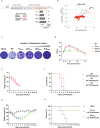Codon-deoptimized single-round infectious virus for therapeutic and vaccine applications
- PMID: 40596017
- PMCID: PMC12215377
- DOI: 10.1038/s41598-025-05643-4
Codon-deoptimized single-round infectious virus for therapeutic and vaccine applications
Abstract
Coxsackievirus B3 (CVB3) is a major cause of myocarditis and acute pancreatitis, particularly in neonates, in whom infections result in severe symptoms and high mortality rates. Despite the urgent need for effective preventive strategies, no vaccines or therapeutic agents have been developed. Live-attenuated vaccines hold promise for combating viral infections; however, their pathogenicity must be carefully regulated without compromising immunogenicity. Here, we investigated codon deoptimization and defective viral genomes (DVGs) as strategies to modulate CVB3 pathogenicity, while preserving its immune-activating capacity. Codon-deoptimized CVB3s with increased CpG dinucleotide content in their 3CD region were engineered, leveraging the innate immunostimulatory properties of CpG. These modified CVB3s exhibited attenuated pathogenicity proportional to the level of codon deoptimization and induced protective immunity against wild-type CVB3 (CVB3WT), making them viable live-attenuated vaccine candidates. Additionally, DVGs derived from codon-deoptimized CVB3 demonstrated superior viral interference and enhanced stimulation of neutralizing antibody production compared to DVGs derived from CVB3WT. These findings highlight that CpG-enriched genomes and DVGs are promising tools for regulating viral pathogenicity, enhancing vaccine safety, and developing therapeutic strategies against viral infections.
Keywords: Codon deoptimization; Coxsackievirus B3; CpG dinucleotide; Defective viral genomes; Live-attenuated vaccines.
© 2025. The Author(s).
Conflict of interest statement
Declarations. Competing interests: T.N., T.S., P.M., and H.E. are employees of BIKEN, with H.E. holding a managerial position. A.M. declares no competing interests. Appropriate measures were taken to ensure that these affiliations did not influence the study’s design, data collection, analysis, or interpretation. Ethics approval: All experiments were carried out in accordance with relevant guidelines and regulations. This study is reported in accordance with ARRIVE guidelines.
Figures



Similar articles
-
Coxsackie B1 virus-like particle vaccine modified to exclude a highly conserved immunoreactive region from the capsid induces potent neutralizing antibodies and protects against infection in mice.J Biomed Sci. 2025 Sep 8;32(1):86. doi: 10.1186/s12929-025-01183-1. J Biomed Sci. 2025. PMID: 40922007 Free PMC article.
-
Innovative use of gram-positive enhancer matrix particles and affinity peptides in a vaccine against Coxsackievirus B3.Virulence. 2025 Dec;16(1):2481657. doi: 10.1080/21505594.2025.2481657. Epub 2025 May 14. Virulence. 2025. PMID: 40174632 Free PMC article.
-
Attenuated strain of CVB3 with a mutation in the CAR-interacting region protects against both myocarditis and pancreatitis.Sci Rep. 2021 Jun 14;11(1):12432. doi: 10.1038/s41598-021-90434-w. Sci Rep. 2021. PMID: 34127684 Free PMC article.
-
Vaccines for preventing influenza in healthy children.Cochrane Database Syst Rev. 2018 Feb 1;2(2):CD004879. doi: 10.1002/14651858.CD004879.pub5. Cochrane Database Syst Rev. 2018. PMID: 29388195 Free PMC article.
-
Immunogenicity and seroefficacy of pneumococcal conjugate vaccines: a systematic review and network meta-analysis.Health Technol Assess. 2024 Jul;28(34):1-109. doi: 10.3310/YWHA3079. Health Technol Assess. 2024. PMID: 39046101 Free PMC article.
References
-
- Garmaroudi, F. S. et al. Coxsackievirus B3 replication and pathogenesis. Futur. Microbiol.10, 629–653. 10.2217/fmb.15.5 (2015). - PubMed
-
- Carre, A., Vecchio, F., Flodstrom-Tullberg, M., You, S. & Mallone, R. Coxsackievirus and type 1 diabetes: Diabetogenic mechanisms and implications for prevention. Endocr. Rev.44, 737–751. 10.1210/endrev/bnad007 (2023). - PubMed
-
- Deng, H. et al. An intranasal attenuated coxsackievirus B3 vaccine induces strong systemic and mucosal immunity against CVB3 lethal challenge. J. Med. Virol.96, e29831. 10.1002/jmv.29831 (2024). - PubMed
MeSH terms
Substances
LinkOut - more resources
Full Text Sources

